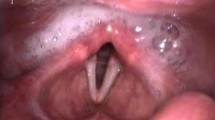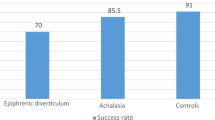Abstract
Zenker’s diverticulum (ZD) is an uncommon condition characterized by formation of a pseudodiverticulum in the hypopharynx that presents with considerable variability in swallowing symptomatology. Identifying radiographic features of ZD most associated with clinical impact could prove useful in counseling patients and predicting treatment response. This study was a retrospective case series of patients undergoing videofluoroscopic swallowing studies (VFSS) for Zenker’s diverticulum at a tertiary dysphagia center. Anatomic parameters identified on VFSS of patients with ZD were correlated with subjective perception of swallowing using Eating Assessment Tool (EAT-10) scores. Upper esophageal sphincter (UES) opening at the point of maximal distention, area of diverticulum on the lateral view, height of the diverticulum, and entrance angle of the esophagus were measured. We identified 40 patients with ZD (52.5% male, mean age = 71.2 years). Narrow UES opening was significantly correlated with dysphagia severity (r = − 0.3445, p = 0.035). Largest area of diverticulum (r = 0.0188, p = 0.87), diverticulum height (r = 0.1435, p = 0.45), and esophageal entrance angle (r = 0.1677, p = 0.42) were not correlated with EAT-10 scores. Maximum UES opening size was predictive of severity of swallowing dysfunction in patients with ZD. Size of ZD and the angle of bolus entry in patients with ZD are not predictive of swallowing dysfunction. Understanding the predictors of swallowing dysfunction will assist in counseling patients on postoperative expectations.


Similar content being viewed by others
Abbreviations
- AHS:
-
Alberta Health Services
- SD:
-
Standard deviation
- EAT-10:
-
Eating Assessment Tool-10
- PSHR:
-
Post-swallow hypopharyngeal reflux
- UES:
-
Upper esophageal sphincter
- VFSS:
-
Videofluroscopic swallow study
- ZD:
-
Zenker’s diverticulum
References
Laing MR, Murthy P, Ah-See KW, Cockburn JS. Surgery for pharyngeal pouch: audit of management with short- and long-term follow-up. J R Coll Surg Edinb. 1995;40:315–8.
Ferreira LEVVC, Simmons DT, Baron TH. Zenker’s diverticula: pathophysiology, clinical presentation, and flexible endoscopic management. Dis Esophagus. 2008;21:1–8. https://doi.org/10.1111/j.1442-2050.2007.00795.x.
Maran AG, Wilson JA, Al Muhanna AH. Pharyngeal diverticula. Clin Otolaryngol Allied Sci. 1986;11:219–25. https://doi.org/10.1111/j.1365-2273.1986.tb01923.x.
Nguyen HC, Urquhart AC. Zenker’s diverticulum. Laryngoscope. 1997;107:1436–40. https://doi.org/10.1097/00005537-199711000-00003.
Cook IJ. Cricopharyngeal function and dysfunction. Dysphagia. 1993;8:244–51. https://doi.org/10.1007/bf01354546.
Dohlman G, Mattsson O. The endoscopic operation for hypopharyngeal diverticula: a roentgencinematographic study. AMA Arch Otolaryngol. 1960;71:744–52. https://doi.org/10.1001/archotol.1960.03770050004002.
Siddiq MA, Sood S, Strachan D. Pharyngeal pouch (Zenker’s diverticulum). Postgrad Med J. 2001;77:506–11. https://doi.org/10.1136/pmj.77.910.506.
Law R, Katzka DA, Baron TH. Zenker’s Diverticulum. Clin Gastroenterol Hepatol. 2014. https://doi.org/10.1016/j.cgh.2013.09.016.
Schindler A, Mozzanica F, Alfonsi E, et al. Upper esophageal sphincter dysfunction: diverticula-globus pharyngeus. Ann N Y Acad Sci. 2013;1300:250–60. https://doi.org/10.1111/nyas.12251.
Morton RP, Bartley JR. Inversion of Zenker’s diverticulum: the preferred option. Head Neck. 1993;15:253–6. https://doi.org/10.1002/hed.2880150315.
Belafsky PC, Mouadeb DA, Rees CJ, et al. Validity and Reliability of the Eating Assessment Tool (EAT-10). Annals of Otology, Rhinology & Laryngology. 2008;117:919–24. https://doi.org/10.1177/000348940811701210.
Martin-Harris B, Brodsky MB, Michel Y, et al. MBS measurement tool for swallow impairment–MBSImp: establishing a standard. Dysphagia. 2008;23:392–405. https://doi.org/10.1007/s00455-008-9185-9.
Bergeron JL, Long JL, Chhetri DK. Dysphagia characteristics in Zenker’s diverticulum. Otolaryngol Head Neck Surg. 2013;148:223–8. https://doi.org/10.1177/0194599812465726.
Ishaq S, Siau K, Lee M, et al. Zenker’s Diverticulum: Can Protocolised Measurements with Barium SWALLOW Predict Severity and Treatment Outcomes? The “Zen-Rad” Study. Dysphagia. 2020. https://doi.org/10.1007/s00455-020-10148-5.
Allen J, Blair D, Miles A. Assessment of videofluoroscopic swallow study findings before and after cricopharyngeal myotomy. Head Neck. 2017;39:1869–75. https://doi.org/10.1002/hed.24846.
Yip HT, Leonard R, Kendall KA. Cricopharyngeal myotomy normalizes the opening size of the upper esophageal sphincter in cricopharyngeal dysfunction. Laryngoscope. 2006;116:93–6. https://doi.org/10.1097/01.mlg.0000184526.89256.85.
Oestreicher-Kedem Y, Wasserzug O, Sagi B, et al. Revision endoscopic stapler Zenker’s diverticulotomy. Surg Endosc. 2016;30:2022–5. https://doi.org/10.1007/s00464-015-4435-z.
Belafsky PC, Mouadeb DA, Rees CJ, et al. Validity and reliability of the Eating Assessment Tool (EAT-10). Ann Otol Rhinol Laryngol. 2008;117:919–24. https://doi.org/10.1177/000348940811701210.
Mittal C, Diehl DL, Draganov PV, et al. Practice patterns, techniques, and outcomes of flexible endoscopic myotomy for Zenker’s diverticulum: a retrospective multicenter study. Endoscopy. 2020. https://doi.org/10.1055/a-1219-4516.
Junlapan A, Abu-Ghanem S, Sung CK, Damrose EJ. Outcomes in modified transoral resection of diverticula for Zenker’s diverticulum. Eur Arch Otorhinolaryngol. 2019;276:1423–9. https://doi.org/10.1007/s00405-019-05374-z.
Resouly A, Braat J, Jackson A, Evans H. Pharyngeal pouch: link with reflux and oesophageal dysmotility. Clin Otolaryngol Allied Sci. 1994;19:241–2. https://doi.org/10.1111/j.1365-2273.1994.tb01223.x.
Rosen SP, Jones CA, Hoffman MR, et al. Pressure abnormalities in patients with Zenker’s diverticulum using pharyngeal high-resolution manometry. Laryngoscope Investig Otolaryngol. 2020;5:708–17. https://doi.org/10.1002/lio2.434.
Fulp SR, Castell DO. Manometric aspects of Zenker’s diverticulum. Hepatogastroenterology. 1992;39:123–6.
Miles A, Clark S, Jardine M, Allen J. Esophageal Swallowing Timing Measures in Healthy Adults During Videofluoroscopy. Ann Otol Rhinol Laryngol. 2016;125:764–9. https://doi.org/10.1177/0003489416653410.
Cates D, Plowman EK, Mehdizadeh O, et al. Geometric morphometric shape analysis in an ovine model confirms that the upper esophageal sphincter is not round. Laryngoscope. 2013;123:721–6. https://doi.org/10.1002/lary.23634.
Randall DR, Cates DJ, Strong EB, Belafsky PC. Three-dimensional analysis of the human pharyngoesophageal sphincter. Laryngoscope. 2019. https://doi.org/10.1002/lary.28450.
Funding
None
Author information
Authors and Affiliations
Corresponding author
Ethics declarations
Conflict of interest
The auhtors declare that they have no conflict of interest.
Additional information
Publisher's Note
Springer Nature remains neutral with regard to jurisdictional claims in published maps and institutional affiliations.
Rights and permissions
About this article
Cite this article
Hanna, R., Randall, D.R. Correlating Dysphagia Severity with Fluoroscopic Parameters in Patients with Zenker's Diverticulum. Dysphagia 36, 999–1004 (2021). https://doi.org/10.1007/s00455-020-10230-y
Received:
Accepted:
Published:
Issue Date:
DOI: https://doi.org/10.1007/s00455-020-10230-y




